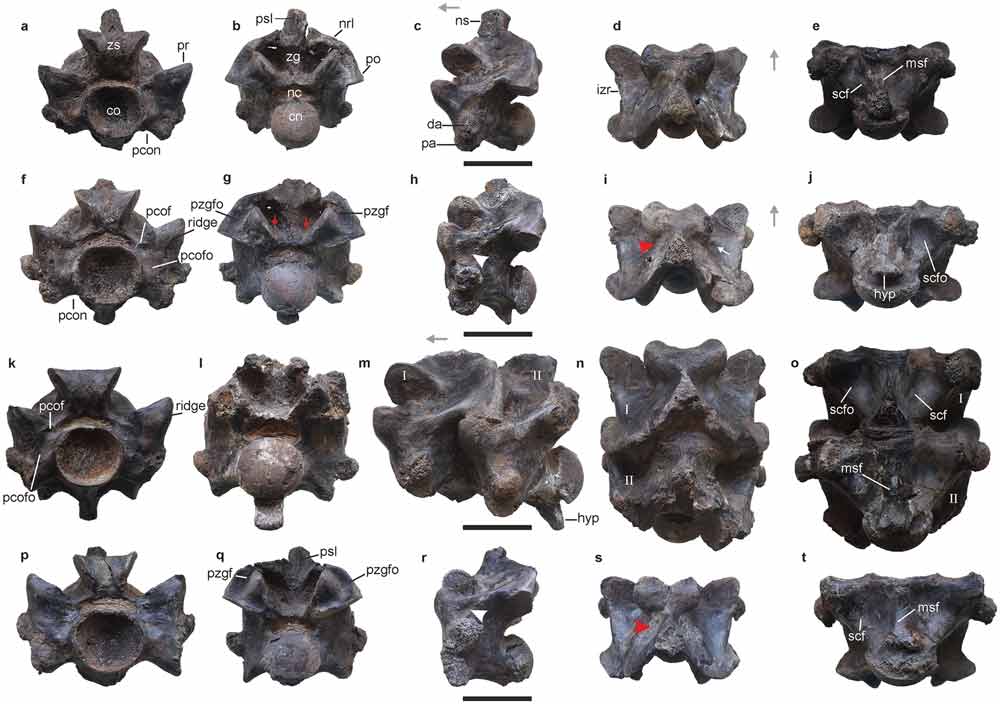The snake fossil, Vasuki indicus gen. et sp. nov. is named after the Hindu mythical snake Vāsuki that was always found around the neck of Lord Shiva. Indicus refers to the country of origin, which is India.
Researchers Debit Datta and Sunil Bajpai with the Department of Earth Sciences, Indian Institute of Technology Roorkee in Uttarakhand, India have described what may be the largest madtsoiid snake fossil ever discovered. Based on its vertebrae, the snake measured between 36 to 49 feet (11 to 15 meters) in length when it roamed the earth around 47 million years ago.
The snake fossil, Vasuki indicus gen. et sp. nov. is named after the Hindu mythical snake Vāsuki that was always found around the neck of Lord Shiva. Indicus refers to the country of origin, which is India.
Vasuki indicus was first discovered in the Panandhro Lignite Mine in the Naredi Formation in Gujarat state, western India. Of the madtsoiid snake family that is now extinct, the snake represents a distinct lineage. Madtsoiid snakes roamed the earth for about 100 million years from the late Cretaceous to the Late Pleistocene period and were found in what is now Africa, Europe and India.

Anterior trunk vertebrae of Vasuki indicus. IITR/VPL/SB 3102-3, partial vertebra in anterior view (a); posterior view (b); left lateral view (c); dorsal view (d); ventral view (e). IITR/VPL/SB 3102-5, complete vertebra in anterior view (f); posterior view (g); left lateral view (h); dorsal view (i); ventral view (j). IITR/VPL/SB 3102-7I-II, partial vertebra in anterior view (k); posterior view; (l); left lateral view (m); dorsal view (n); ventral view (o). IITR/VPL/SB 3102-6, complete posterior anterior trunk vertebra in anterior view (p); posterior view (q); left lateral view (r); dorsal view (s); ventral view (t). Grey arrows indicate anterior direction. Red arrowheads and arrows indicate fossae on neural spinal base and endozygantral foramina, respectively. Roman numerals on figures (m–o) refer to individual vertebrae in articulated specimens where ‘I” is towards the anterior. White arrowhead and arrow indicate fossa medial to diapophysis and foramen on dorsal surface of neural arch. co cotyle, cn condyle, da diapophysis, hyp hypapophysis, izr interzygapophyseal ridge, msf median shaft, nc neural canal, nrl neural arch lamina, ns neural spine, pa parapophysis, pcof paracotylar foramen, pcofo paracotylar fossa, pcon paracotylar notch, po postzygapophysis, pr prezygapophysis, psl prespinal lamina, pzgf parazygantral foramen, pzgfo parazygantral fossa, scf subcentral foramen, scfo subcentral fossa, zg zygantrum, zs zygosphene. Scale bar represents 50 mm.
Datta and Bajpai rely on 27 vertebrae of the reptile to describe it. They measured between 27.5 and 62.7 mm in length and 62.4 and 111.4 mm in width. The researchers believe that the snake’s large size makes it a slow moving ambush predator similar to an anaconda.
Video: See The Building Of The Titanoboa Replica in 36 Seconds
The complete paper describing this giant snake fossil, “Largest known madtsoiid snake from warm Eocene period of India suggests intercontinental Gondwana dispersal” can be read on the Scientific Reports website.


